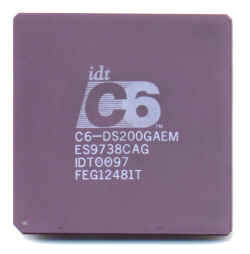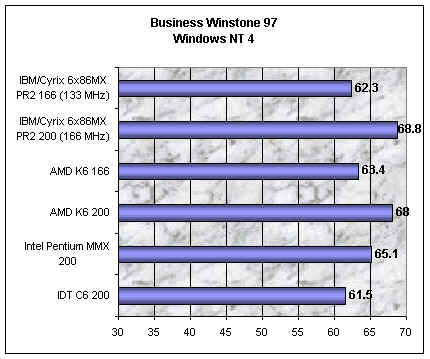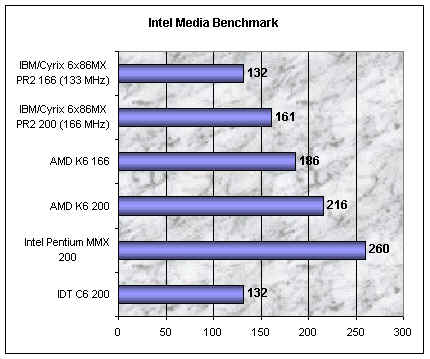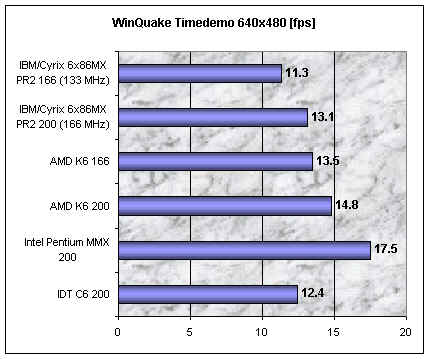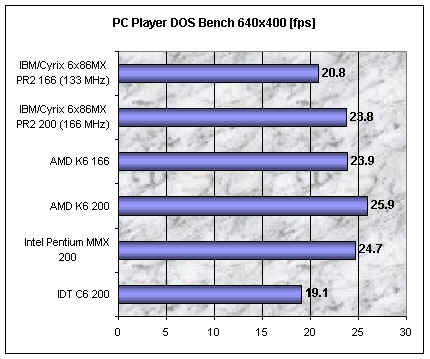The IDT WinChip C6 CPU
Introduction
When IDT announced the C6 CPU in the first half of this year it came as quite a surprise to most of us. The C6 became then the star of the Computex show in Taipei in June this year. After this first introduction it became pretty quiet around IDT again and only now this new Socket 7 CPU starts shipping. Targeted against the Intel Pentium MMX, IDT claimed that the C6 has got about the same integer performance at the same clock speed as the Pentium MMX. IDT was also not making any secret of the fact that the floating point as well as the MMX unit of the C6 will not be as fast as in the Intel Pentium MMX. The C6 is targeted to the lower end market, similar to the lower clocked versions of the AMD K6 and the IBM/Cyrix 6x86MX CPUs. The special trick of IDT is supposed to be the fact that the chip is fairly small as well as requiring only little power and IDT is therefore pretty confident of raising the clock speed to up to 400 MHz soon as well as using the C6 in notebooks where low power consumption is crucial.
The architecture of the C6 is much less sophisticated than the architecture of its competitors AMD K6 and IBM/Cyrix 6x86MX. No 'register renaming' or 'out of order execution' is used here for reaching Pentium MMX performance but simply a large L1 cache in cooperation with a pretty classic but straight forward microprocessor design.
At the Computex in June IDT only showed a few systems with C6 CPUs running at 150 or 180 MHz. I also had one 150 MHz engineering sample a few months ago which couldn't really impress me a lot. Now IDT shipped a whole system to me with a 200 MHz C6 so that I could test if this new Socket 7 CPU is living up to its claims. I compared the C6 200 to the Intel Pentium MMX 200, the AMD K6 166 and 200 and the IBM/Cyrix 6x86MX PR2 166 (running at 133 MHz) and PR2 200 (166 MHz). The price of the C6 200 lies pretty much somewhere in between these CPUs, with the Intel Pentium MMX as the most expensive, the IBM/Cyrix 6x86 PR2 166 as the cheapest.
The Benchmark Runs
The first surprise to me was the voltage the C6 is running at. It requires 3.52 V, not exactly what you would expect of a low power CPU. However the C6 stays very cool and so do the voltage regulators which can be seen as a sign for low power consumption. The C6 is supposed to only use 10W at 3.52V, much less than its competitors at lower voltages. The high voltage it needs, formerly used by the Pentium Classic, the AMD K5 and the IBM/Cyrix 6x86 CPUs, is not necessarily a disadvantage. It gives owners of older motherboards the chance of using this CPU without any problem, opposed to the new voltage requirements of the Pentium MMX, K6 and 6x86MX which isn't offered on many older boards. The really great thing about the C6 is that it doesn't necessarily need a BIOS update either for running properly, although IDT says that the special C6-'write combining'-feature will increase the performance of a C6 by about 1-2% and this feature is usually enabled by the BIOS. If the BIOS recognizes the C6, you can expect this feature to be enabled. Otherwise the BIOS may tell you crazy stuff as '486DX' or just 'CPU' at strange clock speeds at bootup, but the C6 will still run fine. The jumper setting needed for the C6 are exactly the same as for the Pentium, there's no annoying and misleading PR-rating.
I tested the C6 in the FIC PA-2007 board, which still is one of the fastest Socket 7 boards available. It also offers 'linear burst' to enable full performance of the 6x86MX CPU. The video card was my good old Matrox Millennium w/ 4 MB, BIOS 2.5, Win95 Driver 3.70, NT Driver 3.20, Diamond Monster 3D, 64 MB SDRAM, Quantum Fireball 1280, DPT PM2144UW and Seagate Cheetah ST34501W for the NT runs.
The CPUs were tested under Windows 95 OSR2.1 and Windows NT 4.0 SP3. The tested features were integer performance, floating point performance, 3D and DOS gaming performance.
The Business Winstone performance under Windows 95 is what made IDT say that their C6 is as fast as the Pentium MMX at the same clock speed. As we can see the sixth generation CPUs K6 and 6x86MX are leading here when run at the 200 rating. Here the C6 does fulfil the promises of IDT indeed.
Get Tom's Hardware's best news and in-depth reviews, straight to your inbox.
The IDT C6 is the only CPU with '200-rating' that falls behind, the Pentium, K6 and 6x86MX are pretty much at the same level.
NT is not the friend of the C6 and under this OS the claims of IDT are not fulfilled. Slightly behind the 6x86MX PR2 166 it makes only fourth place.
The NT Highend Winstone combines the C6's NT weakness with its slow FPU, so that the lead of the Pentium MMX and the K6 is even more obvious.
When it comes down to pure FPU performance the Pentium MMX still rules the Socket 7 market. The Intel CPU needs less than half the render time of the C6 and the 6x86MX. However the C6 is not the worst CPU here, the IBM/Cyrix PR2 166 processor is obviously having the weakest FPU. The K6 stays well in the middle.
The Benchmark Continued
Testing pure MMX and a little FPU performance with Intel's very own Media Benchmark shows the clear lead of the Pentium MMX, the K6 on a decent second place and the C6 and 6x86MX PR2 166being almost identical. The low numbers are mainly due to the 3D benchmark part of Intel's Media Bench, which is a pure FPU benchmark.
Checking 3D CPU performance with 3DWinbench means checking the FPU performance as well. The Pentium MMX rules this benchmark. And the C6 is only slightly kept from being the loser by the cheaper 6x86MX PR2 166 CPU.
PC Player's new version 2.10 of its popular Direct3D benchmark is not as tough on the FPU. The results show a two class society, upper class is the Intel and the AMD CPU, lower class the IDT and IBM/Cyrix one.
GLQuake on the Monster3D shows that you can play this game with any of these four CPUs (>25 fps) and again we have the two class society with Intel and AMD holding the lead.
WinQuake makes the Pentium MMX to the leader again, with K6, C6 and 6x86MX following far behind.
The DOS version of PC Player's Benchmark shows that for DOS games the Pentium MMX as well as the K6 are the better choice than the 6x86 and the C6.
